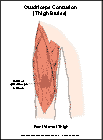
Quadriceps Contusion (Thigh Bruise) and Strain
What is a thigh bruise (quadriceps contusion) and strain?
A thigh bruise is a bruise (contusion) to the large group of muscles in the front of the thigh that help straighten the leg. These muscles are called the quadriceps. A thigh bruise is also called a charley horse. A strain is a partial tear of a muscle and is often called a pulled muscle.
How does it occur?
A thigh bruise is caused by a direct blow to the muscles of the thigh. A strain may be caused by overuse or by a abrupt movement of the thigh in activities such as sprinting or jumping.
What are the symptoms?
You have pain in the middle of your thigh and have difficulty walking or running. You may have difficulty bending or straightening your leg or lifting your knee. An area of your thigh may be swollen and discolored.
A thigh bruise or strain usually heals without complications. However, a large bruise may bleed a lot into the quadriceps muscle. This bleeding is called a hematoma. The hematoma may become calcified and form a hard lump in the quadriceps muscle. This lump is called osteomyositis ossificans and may cause stiffness or a bump in the muscle that may be very long lasting.
How is it diagnosed?
Your health care provider will ask about your symptoms and examine your thigh. If your provider suspects an area of calcification, an x-ray may be ordered.
How is it treated?
Right after your injury your health care provider may wrap your leg in a bent-knee position and place ice over your thigh. This will put a maximum stretch on the thigh muscles, keeping them from becoming too tight or stiff during healing.
Other treatment may include:
- putting ice packs on your thigh for 20 to 30 minutes every 3 to 4 hours for 2 or 3 days or until the pain goes away
- lying down and elevating your thigh by putting a pillow under it
- taking an anti-inflammatory medication prescribed by your health care provider
- wearing an elastic thigh wrap when you return to sports
- having prescribed physical therapy, which would include rehabilitation exercises and deep tissue treatments such as ultrasound or electrical stimulation.
While you are recovering from your injury you will need to change your sport or activity to one that does not make your condition worse. For example, you may need to swim instead of run.
When can I return to my sport or activity?
The goal of rehabilitation is to return you to your sport or activity as soon as is safely possible. If you return too soon you may worsen your injury, which could lead to permanent damage. Everyone recovers from injury at a different rate. Return to your sport or activity will be determined by how soon your thigh recovers, not by how many days or weeks it has been since your injury occurred. In general, the longer you have symptoms before you start treatment, the longer it will take to get better.
You may safely return to your sport or activity when, starting from the top of the list and progressing to the end, each of the following is true:
- You have full range of motion in the injured leg compared to the uninjured leg.
- You have full strength of the injured leg compared to the uninjured leg.
- You can jog straight ahead without pain or limping.
- You can sprint straight ahead without pain or limping.
- You can do 45-degree cuts, first at half-speed, then at full-speed.
- You can do 20-yard figures-of-eight, first at half-speed, then at full-speed.
- You can do 90-degree cuts, first at half-speed, then at full-speed.
- You can do 10-yard figures-of-eight, first at half-speed, then at full-speed.
- You can jump on both legs without pain and you can jump on the injured leg without pain.
How can I prevent a thigh bruise or strain?
A thigh bruise usually occurs from a direct blow to the thigh, which may not be preventable. However, in contact sports such as football be sure to wear the proper protective equipment. Strains are best prevented by warming up and stretching properly before your activity.

